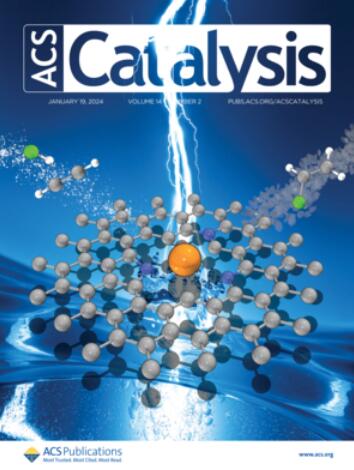Disentangling Plasmonic Enhancement of Electronic and Thermal Effects in Catalysis Using In Operando X-ray Diffraction
IF 11.3
1区 化学
Q1 CHEMISTRY, PHYSICAL
引用次数: 0
Abstract
Photocatalysis by illumination of plasmonic catalytic nanostructures may offer energetically efficient and highly selective alternatives to state-of-the-art thermocatalysis, which typically requires significant energy input for a high temperature operation. While many demonstrations of plasmonic photocatalysis exist, disagreement remains regarding the mechanism(s). Originally, nonthermal (so-called “hot”) carriers appeared responsible for the catalysis, but recently heating emerged as a likely primary mechanism. Distinguishing between these two mechanisms is difficult since it requires accurate knowledge of the catalyst temperature. Here, we report in operando X-ray diffraction under illumination to unambiguously determine the average temperature of the catalyst during CO oxidation by measuring lattice parameters of both the catalytic nanoparticles and their oxide support. By simultaneously measuring the reaction rate, we find that “hot” carriers play no role in this reaction with this catalyst. Our experimental design provides a generally applicable method for the determination of the catalytic mechanism and paves the way for future chemical studies of catalytic plasmonic nanostructures.

用Operando x射线衍射解缠等离子体增强催化中的电子和热效应
等离子体催化纳米结构的光催化可以为最先进的热催化提供能量效率和高选择性的替代方案,而热催化通常需要大量的能量输入来进行高温操作。虽然存在许多等离子体光催化的证明,但关于其机制仍存在分歧。最初,非热(所谓的“热”)载体似乎负责催化,但最近加热出现了一个可能的主要机制。区分这两种机制是困难的,因为它需要准确的催化剂温度知识。在这里,我们报告了在光照下的operando x射线衍射,通过测量催化纳米颗粒及其氧化物载体的晶格参数,明确地确定了CO氧化过程中催化剂的平均温度。通过同时测量反应速率,我们发现“热”载流子在与该催化剂的反应中不起作用。我们的实验设计为确定催化机理提供了一种普遍适用的方法,并为未来催化等离子体纳米结构的化学研究铺平了道路。
本文章由计算机程序翻译,如有差异,请以英文原文为准。
求助全文
约1分钟内获得全文
求助全文
来源期刊

ACS Catalysis
CHEMISTRY, PHYSICAL-
CiteScore
20.80
自引率
6.20%
发文量
1253
审稿时长
1.5 months
期刊介绍:
ACS Catalysis is an esteemed journal that publishes original research in the fields of heterogeneous catalysis, molecular catalysis, and biocatalysis. It offers broad coverage across diverse areas such as life sciences, organometallics and synthesis, photochemistry and electrochemistry, drug discovery and synthesis, materials science, environmental protection, polymer discovery and synthesis, and energy and fuels.
The scope of the journal is to showcase innovative work in various aspects of catalysis. This includes new reactions and novel synthetic approaches utilizing known catalysts, the discovery or modification of new catalysts, elucidation of catalytic mechanisms through cutting-edge investigations, practical enhancements of existing processes, as well as conceptual advances in the field. Contributions to ACS Catalysis can encompass both experimental and theoretical research focused on catalytic molecules, macromolecules, and materials that exhibit catalytic turnover.
 求助内容:
求助内容: 应助结果提醒方式:
应助结果提醒方式:


